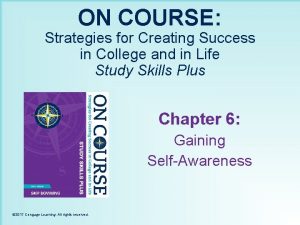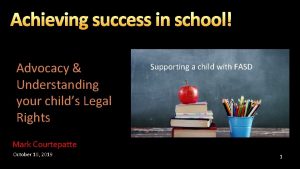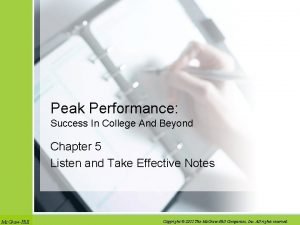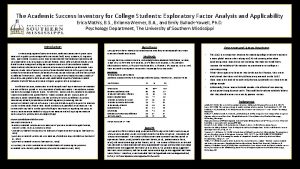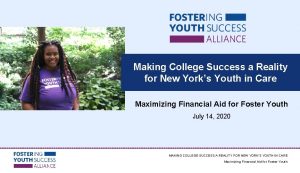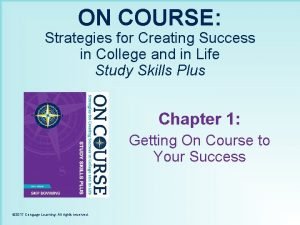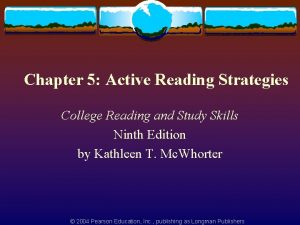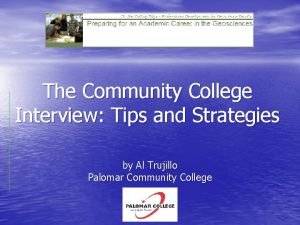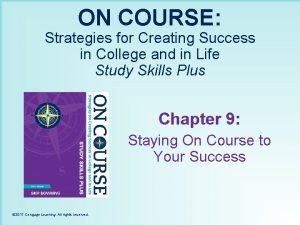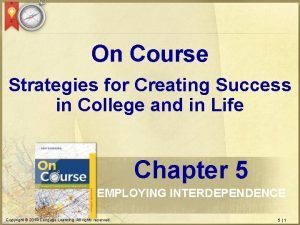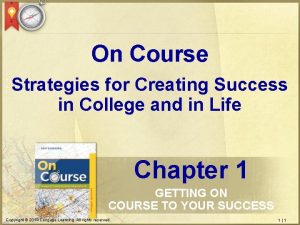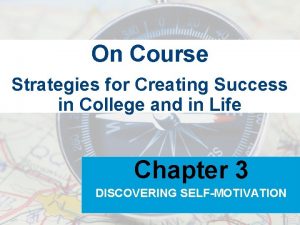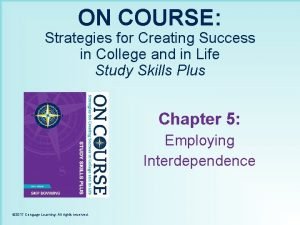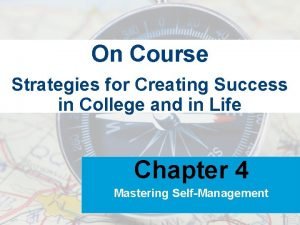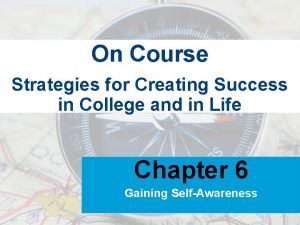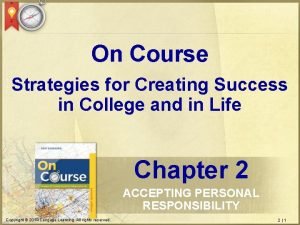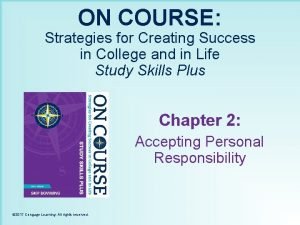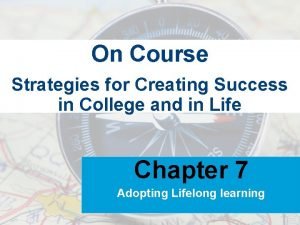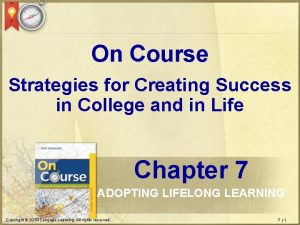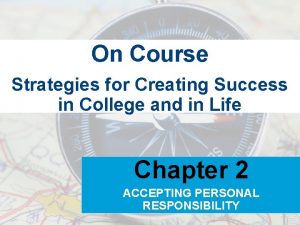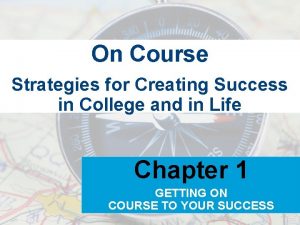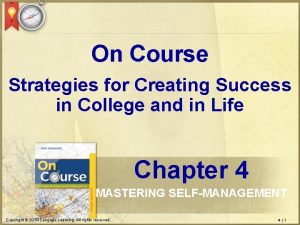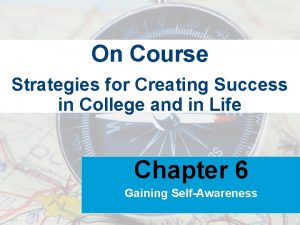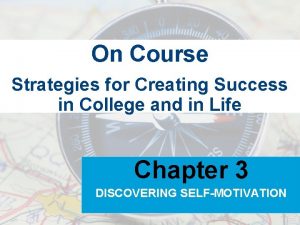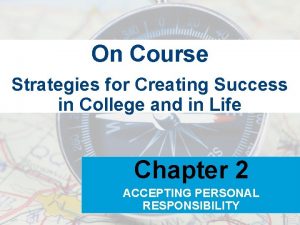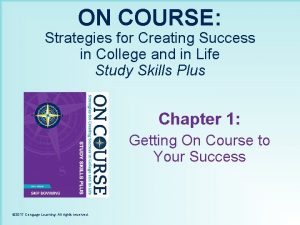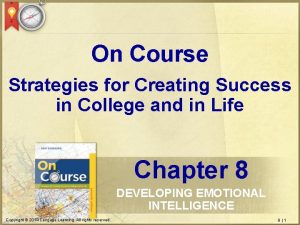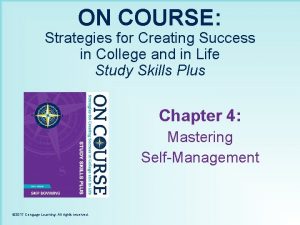On Course Strategies for Creating Success in College













































- Slides: 45

On Course Strategies for Creating Success in College and in Life Chapter 2 ACCEPTING PERSONAL RESPONSIBILITY Copyright © 2014 Cengage Learning. All rights reserved. 2|1

ACCEPTING PERSONAL RESPONSIBILITY • Do you accept personal responsibility for creating the life you want? • Are you a successful student? Ø Have you adopted a creator mindset by believing that your choices create the outcomes and experiences of your life? Ø Have you mastered creator language, accepting personal responsibility for the results? Ø Do you make wise decisions, consciously designing the future you want? Copyright © 2014 Cengage Learning. All rights reserved. 2|2

CRITICAL THINKING: FOCUS QUESTIONS ADOPTING A CREATOR MINDSET • What is self-responsibility? • Why is it the key to creating the life you want? Copyright © 2014 Cengage Learning. All rights reserved. 2|3

THE VICTIM MINDSET • A Victim Mindset causes people to believe that what happens to them is out of their control, that their outcomes and experiences are determined by such things as luck and other people. • Read the following statements and decide if they represent someone with a Victim Mindset. Yes Ø I could never go to college. I don’t even know the first thing about getting started. Yes Ø I wish the college wasn’t so far from my house. I can’t go to school until I get a car. No Ø I have never filled out a college application, but I can go to the school and ask for help. Copyright © 2014 Cengage Learning. All rights reserved. 2|4

THE CREATOR MINDSET • A Creator Mindset causes people to believe they control their own destiny by the wisdom of their choices (even though this belief is not always true). • Read the following statements and decide if they represent someone with a Creator Mindset. No Ø I have never been good in math, so I know I wouldn’t be able to pass the college entrance exam. Yes Ø My best friend's party is this weekend. I think I will do my homework on Friday instead of on Sunday. No Ø I used all my money paying rent and can’t afford to buy my textbooks. I may have to drop out of college. Copyright © 2014 Cengage Learning. All rights reserved. 2|5

ROSA PARKS • In 1955, Rosa Parks, an African American woman, was ordered by a bus driver to give up her seat to a white passenger. Parks refused and was arrested. A few days later, African Americans began a boycott of Montgomery buses that ended when the laws requiring segregation on public buses was lifted. Ø Break into small groups and discuss how this story relates to having a Creator Mindset. Be prepared to give a brief summary of your group’s discussion. Remember to Dive Deep in your thinking. Copyright © 2014 Cengage Learning. All rights reserved. 2|6

ACTIVITY: RESPONSIBILITY AND CULTURE • Imagine an imaginary line from one side of the room to the other. This line represents a continuum of beliefs about personal responsibility. One end represents the belief that you determine your own destiny (internal locus of control). The other end represents the belief that fate or other people determine your destiny (external locus of control). Ø Choose a place to stand on the line that best represents your beliefs. Ø Talk with the people standing next to you on the “line” and find out if there are similarities between you with regard to culture (e. g. , ethnicity, race, religion). Ø What did you discover? Copyright © 2014 Cengage Learning. All rights reserved. 2|7

RESPONSIBILITY AND CHOICE QUOTATION • “When you make the shift to being the predominate creative force in your life, you move from reacting and responding to the external circumstances of your life to creating directly the life you truly want. ” ~Robert L. Fritz Ø Write about a time when you either did or did not act as if you are the “predominate creative force in your own life. ” Ø How did this choice affect your life? Copyright © 2014 Cengage Learning. All rights reserved. 2|8

CRITICAL THINKING: FOCUS QUESTION MASTERING CREATOR LANGUAGE • How can you create greater success by changing your vocabulary? Copyright © 2014 Cengage Learning. All rights reserved. 2|9

SELF TALK: THE INNER CRITIC • The Inner Critic is the internal voice that judges us as inadequate, blames us for whatever is wrong in life, and can find fault with anything about us. • Watch the video in the link below and count how many times the character makes an Inner Critic statement. Ø http: //goanimate. com/videos/0 J 3 zb. IZPT HRs/1 • Did you count 15 Inner Critic statements? If not, go back and listen again Copyright © 2014 Cengage Learning. All rights reserved. 2 | 10

SELF TALK: THE INNER DEFENDER • The Inner Defender judges, blames, complains, accuses, criticizes and condemns others. Ø Write about a time that either you or someone else made Inner Defender statements. Ø Break into groups of 3 -4 and discuss your examples. Ø Also discuss: What lessons can you learn from these examples that can help you be a success in college? Copyright © 2014 Cengage Learning. All rights reserved. 2 | 11

SELF TALK • Divide into 2 groups and discuss how the Inner Critic and Inner Defender are similar and different? • Be prepared to share your findings with the class. Copyright © 2014 Cengage Learning. All rights reserved. 2 | 12

SELF TALK: INNER GUIDE • The Inner Guide seeks to make the best of any situation and knows that judgments do not improve difficult situations. Ø Give an example of when you faced a difficult situation and your Inner Guide helped you to make a wise choice. Ø What was the outcome or experience of your choice? Copyright © 2014 Cengage Learning. All rights reserved. 2 | 13

THE LANGUAGE OF RESPONSIBILITY • Look over the qualities of Victim and Creator language in the chart below. What are some benefits of using Creator language? Victim Language Creator Language Focuses on weaknesses Focuses on how to improve Makes excuses Seeks solutions Complains Turns complaints into requests Compares oneself unfavorably to others Seeks help from those more skilled Blames Accepts responsibility Sees problems as permanent Treats problems as temporary Repeats ineffective behaviors Does something new Tries Does Predicts defeat and give up Thinks positively and looks for a better choice Copyright © 2014 Cengage Learning. All rights reserved. 2 | 14

THE LANGUAGE OF RESPONSIBILITY Change the following Victim language to Creator language • Our classroom is so cold, I can’t even concentrate. I don’t want to be distracted by being cold, so I’ll bring an extra sweater to wear during class. • My roommate bothers me every night and I can’t study. I know my roommate is going to want to talk when I get home, so I’ll study in the library before I leave campus. • The gym is always so crowded that I can’t work out. The gym has been really crowded the last few times I went, so I am going to go at a different time and see if there are fewer people there then. • No matter how hard I study, I’m just no good in chemistry. I find chemistry to be challenging, so I’ll go to the chem lab and find out if there’s a tutor who will help me. Copyright © 2014 Cengage Learning. All rights reserved. 2 | 15

CRITICAL THINKING: FOCUS QUESTIONS MAKING WISE DECISIONS • How can you improve the quality of the decisions you make? • How can you take full responsibility for the outcomes and experiences in your life? Copyright © 2014 Cengage Learning. All rights reserved. 2 | 16

THE WISE CHOICE PROCESS • The Wise Choice Process is a 6 step decision making model that empowers you take full responsibility for creating the life you want. Ø Step 1: What is my present situation? Ø Step 2: How would I like my situation to be? Ø Step 3: What are my possible choices? Ø Step 4: What is the likely outcome of each possible choice? Ø Step 5: Which choice(s) will I commit to doing? Ø Step 6: When and how will I evaluate my plan? Copyright © 2014 Cengage Learning. All rights reserved. 2 | 17

THE WISE CHOICE PROCESS • Think of a problem or challenging situation you are now facing, and write out the first three steps of the Wise Choice Process. • Join a partner and exchange papers. • Read your partner’s paper and add as many choices as you can think of for Step 3. • Exchange papers and continue working through The Wise Choice Process. Ø Did your classmate come up with good choices that you hadn’t thought of? Copyright © 2014 Cengage Learning. All rights reserved. 2 | 18

PERSONAL RESPONSIBILITY AT WORK • If you took responsibility for choosing your ideal career, how could you get more information about possible career choices? • Which of the following would be your first choice for getting information to help you decide on a career? Why? Ø Seek part-time employment doing an entry-level position in a particular career field. Ø Talk to others presently in a career field. Ø Research careers online. Ø Take a career interest inventory. Copyright © 2014 Cengage Learning. All rights reserved. 2 | 19

CRITICAL THINKING: FOCUS QUESTION CHANGE YOUR INNER CONVERSATION • How can you raise your self-esteem by changing your self-talk? Copyright © 2014 Cengage Learning. All rights reserved. 2 | 20

THE CURSE OF STINKIN’ THINKIN’ A + B = C (Activating event + Beliefs = Consequences) Activating Event Belief Consequence Which “internal voice” does this sound like? Instructor didn’t show up for a meeting. “Instructor thinks I am dumb. I’ll never finish college. I’m a failure. ” Got depressed and wasted the evening. Which “internal voice” does this sound like? Instructor didn’t show up for a meeting. “Instructor wont help Got angry and spent me. Instructor doesn’t the night care. ” complaining to friends. Copyright © 2014 Cengage Learning. All rights reserved. 2 | 21

STINKIN’ THINKIN’ & STEREOTYPE THREAT • Using A+B=C when faced with Stereotype Threat Activating Event Belief Consequence Female student taking a math test. Women are not good in math. Female student What do you gets anxious, think the distracted consequence and forgets would be inshe this everything scenario? studied. Copyright © 2014 Cengage Learning. All rights reserved. 2 | 22

DISPUTING IRRATIONAL BELIEFS • Become familiar with your inner voice Ø Dispute irrational beliefs dealing with the stereotype threat that “women are bad in math. ” Offer evidence that your judgments are wrong Offer a positive explanation of the problem Question the importance of the problem Offer a plan to improve the situation I did pretty well in high school math and many women have great jobs using math skills everyday. When I excel in math, I’ll have fewer women to compete against for jobs. I don’t have to be the smartest woman in the class, I just have to continue to learn more everyday. I’ll study every What would be a night, do all good plan ask to homework, improve questions in the class, situation? go to tutoring, and see the instructor during office hours. Copyright © 2014 Cengage Learning. All rights reserved. 2 | 23

QUICK REVIEW • The Wise Choice Process has six steps. List as many of them as you can. What is my present situation? How would I like my situation to be? What are my possible choices? Copyright © 2014 Cengage Learning. All rights reserved. What is the likely outcome of each possible choice? Which choice will I commit to doing? When and how will I evaluate my plan? 2 | 24

QUICK REVIEW • Identify each of the following as Inner Critic, Inner Defender or Inner Guide statements I am failing English because the teacher doesn’t know how to explain things clearly. Inner Defender My car has a flat tire. I’ll ask John if he can give me a ride to school tomorrow while the tire is being fixed. Inner Guide I’m too clumsy and slow to be on the soccer team at school; they would laugh at me if I showed up to practice. Inner Critic I know I won’t get the job I interviewed for; I have never been good at answering questions on the spot. Inner Critic My math book is horrible, so there’s no way anyone can pass that course. Inner Defender I know I have a habit of procrastinating, so I’m going straight home today and pay all my bills so I don’t incur late charges. Inner Guide I know I stutter a lot when I get nervous, so I am going to practice my speech at least one hour every day. Inner Guide My friend said he would buy my textbooks for class, but he didn’t. Now I’m going to fail and it’s all his fault. Copyright © 2014 Cengage Learning. All rights reserved. Inner Defender 2 | 25

QUICK REVIEW • Identify each of the following as a Victim Mindset or as a Creator Mindset. Ø I’ll never pass math. It’s just too hard. Victim Ø My study group is a waste of time. Victim Ø I have a meeting with my teacher to discuss how to improve my grades in English. Creator Ø My coworkers like to gossip a lot; I need to stay to myself so I can get my work done. Creator Ø My roommates yell a lot when the football game is on so I can never concentrate on my studies. Victim Copyright © 2014 Cengage Learning. All rights reserved. 2 | 26

QUICK REVIEW • People respond differently to certain situations. Identify each part of the “A + B = C formula” Ø My instructor didn’t show up for a Activating Event scheduled meeting. Ø I’m not sure what went wrong. Sometimes things just don’t turn out the way they were planned. Ø I need to reschedule with my instructor. Then, I am going to use this time to study for my history class and get ahead in my biology class. Copyright © 2014 Cengage Learning. All rights reserved. Belief Consequence 2 | 27

On Course Strategies for Creating Success in College and in Life Chapter 2 Wise Choices in College READING Copyright © 2014 Cengage Learning. All rights reserved. SS 2 | 28

WISE CHOICES IN COLLEGE: READING • What four things are you Collecting when you read actively? Ø Key concepts Ø Main ideas Ø Secondary ideas Ø Supporting details Copyright © 2014 Cengage Learning. All rights reserved. SS 2 | 29

CHALLENGES WITH READING • In groups of 3 -4, make a list of the biggest challenges you are having with reading assignments for your present courses? ØWhat are three most common reading problems identified by your group? Copyright © 2014 Cengage Learning. All rights reserved. SS 2 | 30

STRATEGIES TO IMPROVE READING: BEFORE READING • You now know that Prior Learning, Quality of Processing and Quantity of Processing are crucial to learning. ØIn groups of 3 -4, create a list of strategies you could use to apply these three concepts before reading an assignment. ØReview the next 2 slides and compare your results. Copyright © 2014 Cengage Learning. All rights reserved. SS 2 | 31

STRATEGIES TO IMPROVE READING: BEFORE READING • Approach reading with a positive attitude. Quality of Processing ØAttitude is the foundation of your success. Get your mind in the mood to learn! • Create a distributed reading schedule. Quantity of ØSpread your reading over time. Processing Cramming leads to superficial and short-lived learning. • Read when you’re most alert. Quality of ØStudy during your mental peak each Processing day. Don’t study when you’re tired. Copyright © 2014 Cengage Learning. All rights reserved. SS 2 | 32

STRATEGIES TO IMPROVE READING: BEFORE READING • Read where you can concentrate. Quality of Processing ØMinimize distractions. • Review past readings. ØMake neural connections stronger Prior by connecting new information to Learning what you already know. • Preview before reading. Prior ØRelate the new material to what you Learning have already learned. Copyright © 2014 Cengage Learning. All rights reserved. SS 2 | 33

STRATEGIES TO IMPROVE READING: BEFORE READING • When you are previewing your reading, what should you be looking for? ble I t a a l i T c s. I f O II. s t L n e t A n T o I C. P I II CA ERS T T LE ? Qu estio ns ? Titles: Headings Copyright © 2014 Cengage Learning. All rights reserved. Bold ies r a m m Su t the end of ry a summa er pt the cha Diagrams Graphs Charts SS 2 | 34

STRATEGIES TO IMPROVE READING: WHILE READING • What are some strategies you could use to decrease the amount of time you spend reading? ØRead in chunks. ØConcentrate on reading faster. ØRead for answers to questions on your list. Copyright © 2014 Cengage Learning. All rights reserved. SS 2 | 35

STRATEGIES TO IMPROVE READING: WHILE READING • Turn to “One Students Story: Dominic Grasseth” in Chapter 2 of your On Course textbook. • Read the first paragraph only. • Write down a brief summary of what you read. • With a partner, compare your summaries. • Are your summaries similar? Ø If not, what can either of you do to improve your summary skills? Copyright © 2014 Cengage Learning. All rights reserved. SS 2 | 36

STRATEGIES TO IMPROVE READING: WHILE READING • How will looking for answers to specific questions help you while you read? • How will writing new questions and answers that you discover while reading, improve your reading? Copyright © 2014 Cengage Learning. All rights reserved. SS 2 | 37

STRATEGIES TO IMPROVE READING: WHILE READING • Turn to “One Students Story: Dominic Grasseth” in Chapter 2 of your On Course textbook. • Read the second paragraph only. • Take a few minutes and think about what you read. • Get into a group of 3 -4 and discuss what is most important in the paragraph. • Mark your text and make annotations in the margin. Ø How will these actions help you when reading? Copyright © 2014 Cengage Learning. All rights reserved. SS 2 | 38

STRATEGIES TO IMPROVE READING: WHILE READING • If you had to read something about which you have no interest, what strategy could you use to avoid mindless reading? ØLook for something that is particularly interesting to you. Øor ØLook for information that you could use. ØIn other words, read for IOUs (Interesting or Useful). Copyright © 2014 Cengage Learning. All rights reserved. SS 2 | 39

STRATEGIES TO IMPROVE READING: WHILE READING • Open your book to the index. • Glance through the index and find a word that you don’t know the meaning of. • Find the word in the textbook using the page number provided in the index. • Determine the meaning of the word by using context clues. • Turn to the person sitting next to you and teach other your new words. Copyright © 2014 Cengage Learning. All rights reserved. SS 2 | 40

STRATEGIES TO IMPROVE READING: WHILE READING • In 2012, the US government spent 2. 1 million dollars on building a “secret” bunker that was to house immigrants for slave labor. ØAfter reading this statement, do you have skepticism about the truth of the statement? ØWhat strategies can you use to read critically and find out if there is any truth to the claim? Copyright © 2014 Cengage Learning. All rights reserved. SS 2 | 41

STRATEGIES TO IMPROVE READING: WHILE READING • Get into three groups. • Each group brainstorm special strategies to use when reading in the following subjects: ØGroup 1: Math ØGroup 2: Science ØGroup 3: Literature • Now form smaller groups of three people, with one person each from Math, Science and Literature. Each person teach the other two people your special reading strategies. Copyright © 2014 Cengage Learning. All rights reserved. SS 2 | 42

STRATEGIES TO IMPROVE READING: AFTER READING • Imagine you just had the best day of your life and your greatest dream had come true. • If you wanted to “relive” that moment, what specifically would you do? ØNow, imagine you just finished reading a fairly difficult textbook. How could you apply those same strategies to ensure learning occurred? Copyright © 2014 Cengage Learning. All rights reserved. SS 2 | 43

STRATEGIES TO IMPROVE READING: ACADEMIC SKILLS PLAN FOR READING • Look over strategies for Reading. • Choose three that you will use immediately. • Explain to a partner the three that you have chosen and why. Copyright © 2014 Cengage Learning. All rights reserved. SS 2 | 44

End Chapter Two Copyright © 2014 Cengage Learning. All rights reserved. 2 | 45
 On course strategies for creating success in college
On course strategies for creating success in college By listening to my inner defender voice i can be sure that
By listening to my inner defender voice i can be sure that Your child's success or lack of success
Your child's success or lack of success Your child's success or lack of success
Your child's success or lack of success Peak performance success in college and beyond
Peak performance success in college and beyond High school gpa as predictor of college success
High school gpa as predictor of college success The academic success inventory for college students
The academic success inventory for college students Foster youth college success initiative
Foster youth college success initiative On course strategies
On course strategies Soldier course vs sailor course
Soldier course vs sailor course Course number and title
Course number and title Course interne course externe
Course interne course externe Active reading strategies college
Active reading strategies college College interview tips and strategies
College interview tips and strategies Formuö
Formuö Typiska novell drag
Typiska novell drag Nationell inriktning för artificiell intelligens
Nationell inriktning för artificiell intelligens Ekologiskt fotavtryck
Ekologiskt fotavtryck Varför kallas perioden 1918-1939 för mellankrigstiden?
Varför kallas perioden 1918-1939 för mellankrigstiden? En lathund för arbete med kontinuitetshantering
En lathund för arbete med kontinuitetshantering Särskild löneskatt för pensionskostnader
Särskild löneskatt för pensionskostnader Vilotidsbok
Vilotidsbok Sura för anatom
Sura för anatom Vad är densitet
Vad är densitet Datorkunskap för nybörjare
Datorkunskap för nybörjare Stig kerman
Stig kerman Mall debattartikel
Mall debattartikel Delegerande ledarskap
Delegerande ledarskap Nyckelkompetenser för livslångt lärande
Nyckelkompetenser för livslångt lärande Påbyggnader för flakfordon
Påbyggnader för flakfordon Arkimedes princip formel
Arkimedes princip formel Svenskt ramverk för digital samverkan
Svenskt ramverk för digital samverkan Jag har nigit för nymånens skära text
Jag har nigit för nymånens skära text Presentera för publik crossboss
Presentera för publik crossboss Jiddisch
Jiddisch Plats för toran ark
Plats för toran ark Klassificeringsstruktur för kommunala verksamheter
Klassificeringsstruktur för kommunala verksamheter Mjälthilus
Mjälthilus Bästa kameran för astrofoto
Bästa kameran för astrofoto Cks
Cks Programskede byggprocessen
Programskede byggprocessen Mat för unga idrottare
Mat för unga idrottare Verktyg för automatisering av utbetalningar
Verktyg för automatisering av utbetalningar Rutin för avvikelsehantering
Rutin för avvikelsehantering Smärtskolan kunskap för livet
Smärtskolan kunskap för livet Ministerstyre för och nackdelar
Ministerstyre för och nackdelar
